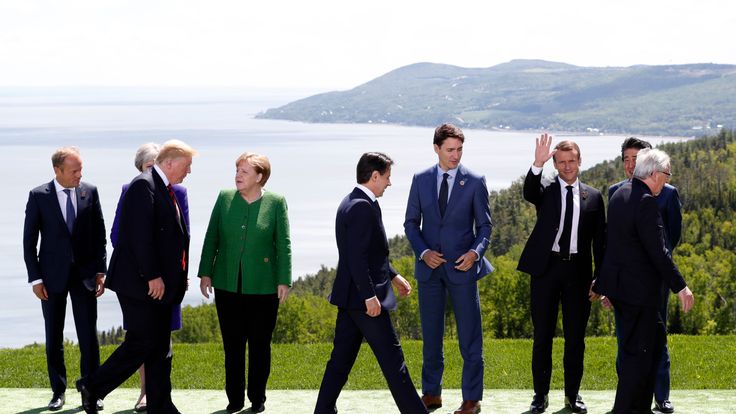What is the G7 and does it really change things?

Friday 23 August 2019 13:57, UK
By Aubrey Allegretti, political reporter
The G7 is entering its 45th year, and will soon see seven of the most powerful people in the world convene for an informal summit.
It has weathered most crises - spanning the Cold War, the global financial crisis and Donald Trump's Twitter posts.
Here are the key things you need to know ahead of the three-day summit kicking off in France on Saturday.
Who and what is the G7?
The Group of Seven (G7) is an informal club of rich democracies who want to strengthen ties and synchronise their views.
Britain, the US, France, Germany, Italy, Canada and Japan are the members, and take turns chairing the annual summit, which usually ends with a series of financial and political commitments.
It has no charter, rule book or bureaucracy of its own.
The summit's decisions are only enforceable through peer pressure and leaders' desire to follow through on their promises, yet that can be significant.
The G7 Research Group at the University of Toronto found that countries complied with 76% of their commitments from last year's summit.
How was it formed?
The G7 was originally a response by leaders of Western democracies to the economic shocks and recession of the mid-1970s.
Those included the collapse of the post-World War II exchange rate system, an oil boycott by Arab countries that led to soaring energy prices, and the worst economic downturn since the Great Depression.
French President Valery Giscard d'Estaing hosted the first summit at Rambouillet, outside Paris, in 1975.
The idea was to get past the bureaucracy and slow decision-making that hobbled larger international organisations to achieve a fast, coherent response to trouble.
Why is it just seven?
The initial group was six, with Canada added in 1976.
Russia joined in 1998 but was suspended over its occupation of Ukraine's Crimean Peninsula in 2014.
The seven members have reached out to outsiders in several ways.
One was to include top officials from the EU as an eighth participant, giving the other member states a voice.
This year, France has invited India, Chile, South Africa and Australia as important regional democracies, plus four African nations: Burkina Faso, Egypt, Senegal, and Rwanda.
What do the leaders discuss?
The agenda typically reflects the big issues of the moment: the host sets the agenda while leaders often meet one-to-one and can discuss anything else.
The global economy was the original focus for the G7.
But it has expanded to tackle security, terrorism, human rights and the environment.
Initiatives have included supporting global trade negotiations, agreeing on economic stimulus and avoiding protectionism, figuring out debt relief for poor countries, and setting up a fund to fight HIV/AIDS, tuberculosis and malaria.
What binds them all together?
As democracies, the G7 have a unity of purpose and trust hard to duplicate in other forums.
The larger G20, which includes states such as China and Russia, includes different models of politics and economic development that do not necessarily include free speech or an emphasis on human rights.
"The co-operation among the G20 is much less routine," says Henning Riecke, head of the transatlantic relations program at the German Council on Foreign Relations.
"The states are more different and there is more friction to be expected.
John Kirton, director of the G7 Research Group, says that "if you need a group of democratically committed powers, the G7 is the only place in the global village to go".
But are they really united?
Donald Trump has shaken up the assumption of close co-operation, particularly by rejecting the support by the other six for the Paris climate accord.
He has also gone his own way by calling for Russia's readmission to the group and caused a stir after 2018's summit when he tweeted criticism of host Candian Prime Minister Justin Trudeau and repudiated the final joint statement.
But the G7 has seen conflict before and survived.
US president Ronald Reagan and French president Francois Mitterrand clashed in 1982 over trade with the Soviet Union. Officials from both countries dismissed key parts of the final statement after.
Notably, it is Mr Trump's turn to host the summit next year, and he may wish to earn some goodwill to ensure an event that burnishes his image ahead of the US presidential election.
Do the summits really change anything?
A two-day summit is too short to find definitive solutions to complex issues.
So the G7 puts its collective clout behind projects carried forward by national governments or in international forums such as the International Monetary Fund or the Organisation for Economic Cooperation and Development.
An example would be debt relief for poor countries.
Partial relief was agreed at the 1988 Toronto summit, but the leaders wrestled with the issue until 2005 in Scotland, where they finally settled the matter - after a total of eight summits.








